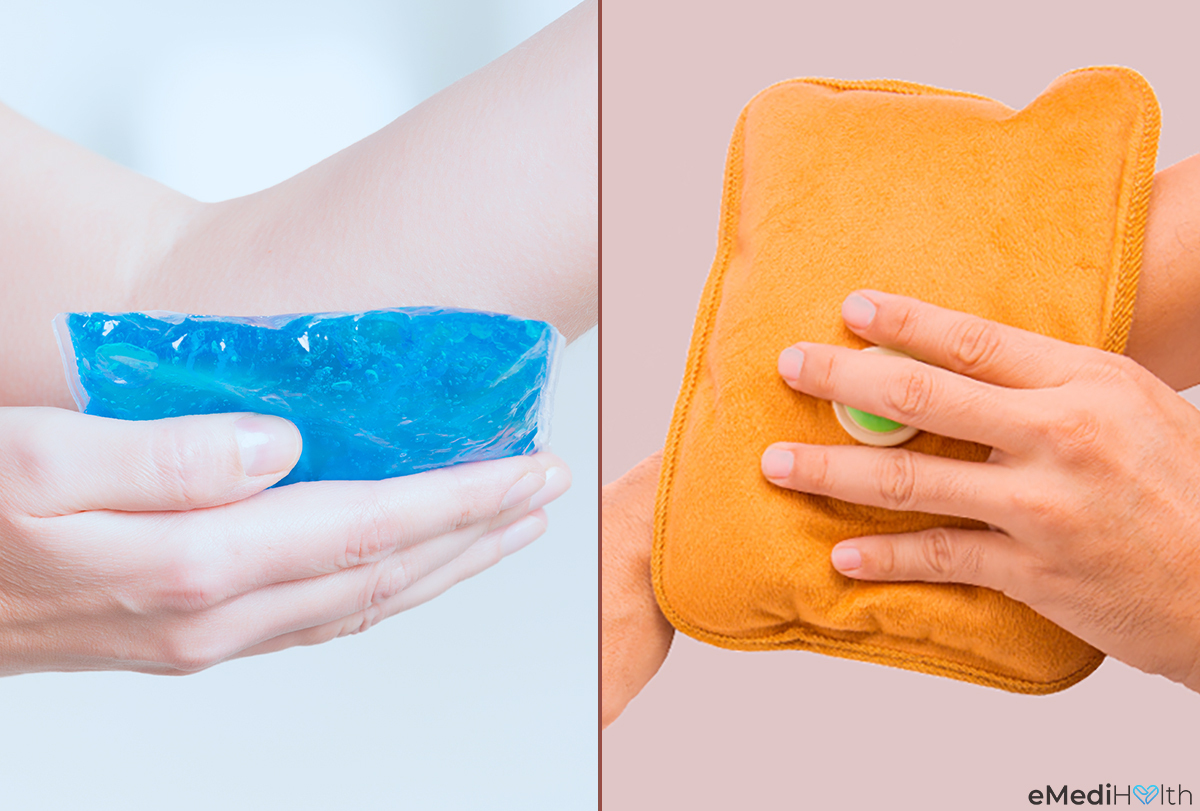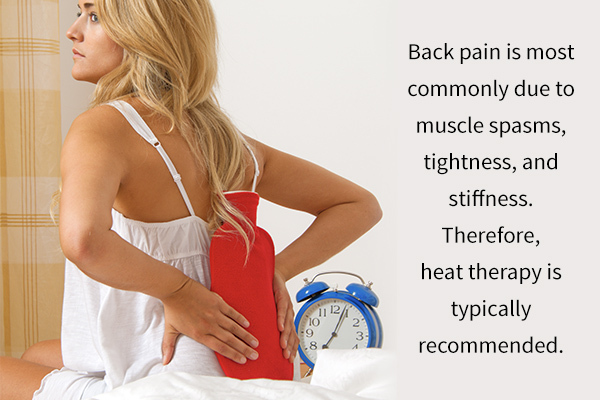In this article:
Heat and cold therapies are two non-medicinal interventions that are commonly used to relieve pain and swelling (1) often in conjunction with other treatment modalities.

Each method has its mechanism for providing relief. Given that both these therapies work differently, deciding which one is better suited for you depends upon the genesis and type of your pain.
Warm Compress
Thermotherapy (2) involves the application of gentle heat to stimulate blood flow and circulation in the targeted area, which helps reduce muscle tension and the associated pain.
Heat therapy can be used for non-inflamed, non-acute body pain. (3) As with cold therapy, there are several ways to apply heat to an injury.
1. Gel hot packs
Gel hot packs are convenient and can be activated when needed, but the temperature does not get very hot and does not last long. For its convenience, though, gel hot packs are still a good option.
Tip: Do not place gel hot packs directly onto the skin. Cover them with a towel to contain the heat more effectively.
2. Other methods
Other methods in applying heat therapy are immersion into warm water, electrical heating pad, and heated body wraps. These methods allow the heat to penetrate the tissue deeper.
There is no standard temperature or duration for heat therapy. Most literature advises a level of heat that is “tolerable” and applying heat therapy until relief is achieved. The main precaution is related to prolonged use of heat and the risk of burning. (Don’t fall asleep on a heating pad!)
Cold Compress

Cryotherapy or cold treatment involves exposing the injured site to cold temperatures, which shrink the underlying blood vessels. This limits blood supply and nerve activity in a localized manner, rendering the area temporarily numb.
Thus, cold therapy produces a short-term anesthetic effect, which makes you feel less pain.
Cold therapy can be applied using raw ice, ice packs, and topical cold sprays. Each method has its benefits.
1. Applying raw ice directly
Applying raw ice directly to the injured area is very effective because as the ice melts, the cold water spreads into the wrinkles of the skin, conducting heat away. Keep the ice moving to avoid a cold burn.
Tip: Try freezing water into small Styrofoam cups. When ice therapy is needed, tear away a portion of the Styrofoam and apply it.
2. Topical cold sprays
Topical cold sprays are a convenient way to apply cold therapy to an injury. These sprays contain a refrigerant that evaporates from the skin almost immediately after spraying.
Trained personnel should be the only ones applying cold sprays, as there is a risk of cold burn if incorrectly sprayed.
3. Ice packs
Ice packs can provide prolonged and deeper tissue cooling effects, (4) unlike raw ice or cold sprays. It is best used for muscle injury.
If a deep cooling effect is desired, cover the skin with a towel, and then cover the pack to contain the cold. The cold pack may be left in place until the area is numb and then removed.
When applying cold therapy, remember these rules:
- Start cold therapy as soon as possible after an injury or in the 48 hours following the injury for the best results.
- Keep the ice moving if applying to bare skin.
- Cover the skin if using an ice pack.
- Apply the cold treatment only until the area is numb.
- Reapply the cold treatment when the pain returns.
- Continue treatment cycles until the symptoms improve.
ALSO READ: Ice Therapy: When and How to Use It Correctly
Warm and Cold Compresses for Muscle Pain
There are specific scenarios in which cold treatment (cryotherapy) is preferred over hot treatments and vice versa for relieving muscle pain.
The pain that follows a strenuous activity is triggered by the release of inflammation mediators from the damaged muscle. (5) This activates the pain receptors (proprioceptors) near the muscle’s blood vessels, thus causing the pain sensation.
Keeping in mind how muscle pain occurs, it becomes clear why cold treatment would be recommended immediately following an injury.
Cold compress
The cold constricts the blood vessels that carry the inflammation chemicals to their pain receptors.
Cold temperature also numbs the injured area and prevents bruising, which is the blood that has leaked from tiny broken blood vessels (capillaries) near the skin’s surface.
Cold treatment is a safe, non-medicinal way to treat minor, localized pain. It works best if applied immediately after the injury and up to 48 hours following.
Warm compress
If the injury is subacute (>48 hours old) or chronic (>6 weeks), then heat is the better option for pain control.
Heat dilates the blood vessels, allowing more blood flow to clear the inflammation mediators away from the area, improving pain. Heat can also improve the muscle tightness, stiffness, and spasms that cause pain.
Because heat increases circulation to the area, it should not be used to treat a new injury. Otherwise, there will be more swelling, more pain, and delayed healing.
Contrasting Therapy With Cold and Warm Compresses
Alternating hot and cold treatment is called contrasting therapy. (6) This technique stimulates the muscle, improves blood flow, and relieves tightness, thus exhibiting an analgesic effect.
Pain related to injuries that are older than 48 hours or during the recovery phase of healing should benefit from alternating warm and cold compresses.
Which Type of Therapy Is Best Suited for Back Pain?

Back pain is most commonly due to muscle spasms, tightness, and stiffness. Therefore, heat therapy is typically recommended.
Even if the back pain is acute, using ice therapy on the lower back may increase the pain. Cold triggers increase muscle tightness, whereas heat can help relax tense muscles.
Neither heat nor ice has been proven very effective in relieving back pain. (7) The bottom line is to do whichever method improves the symptom!
Seek immediate medical attention if the pain is severe or associated with other symptoms such as numbness or weakness in the legs, a sudden difficulty with bladder control, or other neurologic symptoms.
Cold Compress for Fever
A cold compress may be used to reduce a fever temporarily in both children and adults but should not be used in infants or babies. Use a towel soaked in an ice bath, ring out the excess water and then dab the towel onto the skin. Dry the skin immediately with a separate towel.
Do not immerse the ill individual into an ice bath because the extreme cold temperature will cause shivering and elevate the body temperature even further. Always seek medical attention for persistent fever!
Cautionary Points
Prolonged exposure of bare skin to extreme temperatures can be dangerous and can lead to tissue damage.
- Use caution, especially if there is decreased sensation in the area being treated (such as in cases of diabetic neuropathy and Reynaud’s phenomenon).
- Avoid using either hot or cold treatment on areas that appear infected (painful, red, hot, swollen, oozing skin).
- Hot and cold therapy is recommended for minor pain or injury – not major trauma, abraded or open skin areas, or if symptoms are severe or prolonged. Seek medical attention for serious or concerning pain reasons.
Final Word
Cold and warm compresses are both effective therapies used commonly for relieving pain. However, it can be quite confusing to make a choice between the two during treatment.
It is important to remember that heat increases blood flow and is therefore helpful in reducing joint stiffness and muscle spasm. Cold therapy, on the other hand, numbs the area and reduces swelling.
- Was this article helpful?
- YES, THANKS!NOT REALLY


